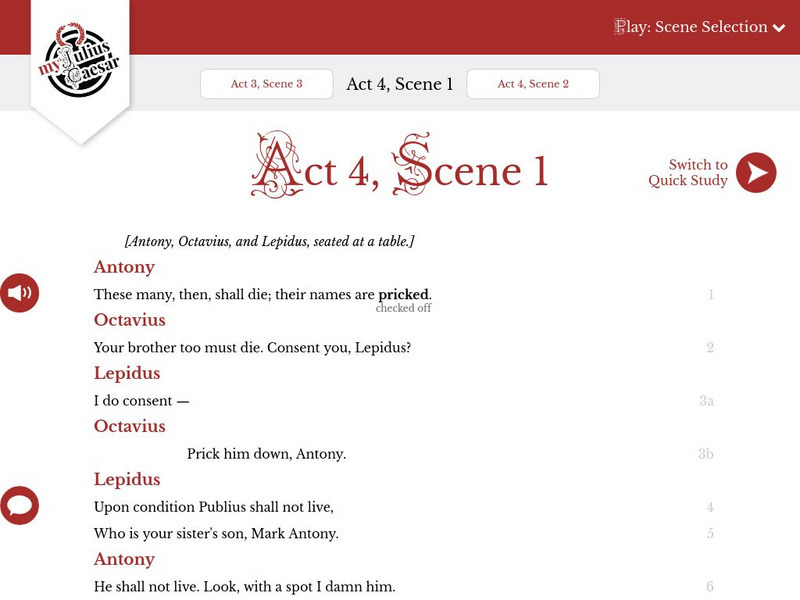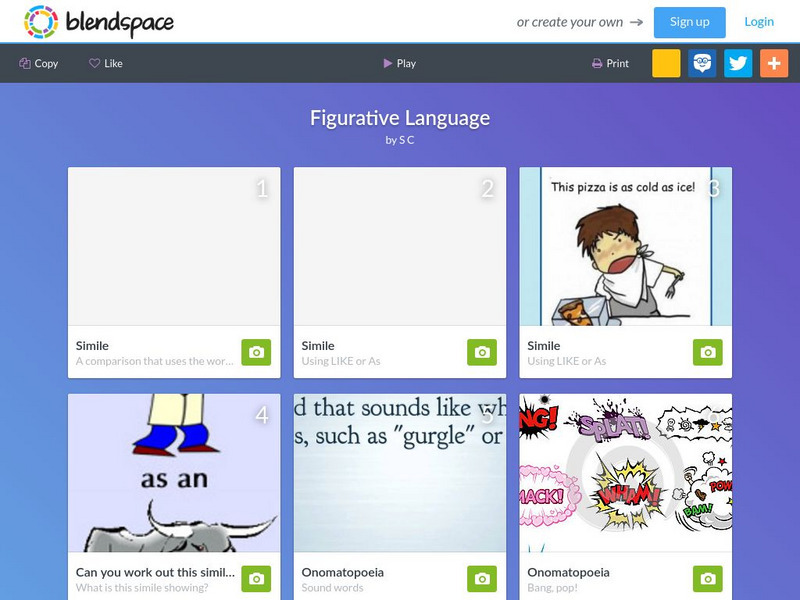Alabama Learning Exchange
Alex: Figurative Language
This lesson used a slideshow presentation to explain the difference between similes and metaphors. Students are challenged to identify these figurative elements in literature and then create some themselves.
Alabama Learning Exchange
Alex: Poetry and Music Fun With Chris Daughtry
This language arts lesson grabs students' attention by incorporating a popular musician. The lyrics to "Over You" include vivid language that makes identifying figures of speech intriguing. The students will identify similes, metaphors,...
Other
Paradigm Education: My Shakespeare: Julius Caesar, Act 4, Scene 1
The text of Act IV of The Tragedy of Julius Caesar, accompanied by audio narration. Be sure to advance to scenes 2 and 3 (or to other acts of the play) using the buttons at the top. Includes audio narration, performance clips, discussion...
E Reading Worksheets
E Reading Worksheets: Figurative Language Worksheets
This learning module provides remediation and extra practice with identifying different types of figurative language. Reinforcement is provided through the worksheets, quizzes, video game links, and online sites for the following types...
Read Works
Read Works: Figurative Language 3rd Grade Unit
[Free Registration/Login Required] In this three-instructional activity unit, students use the book If You Hopped Like a Frog by David Schwartz and some additional short texts to learn to identify and understand the use of simile and...
Houghton Mifflin Harcourt
Holt, Rinehart and Winston: Elements of Literature: Identifying Figures of Speech [Pdf]
A graphic organizer which allows students to document and list the figures of speech they identify in a given piece of literature. These include simile, metaphor, personification, and symbol, and require examples from the text.
ReadWriteThink
Read Write Think: Teaching Poetry Through Riddles
Excellent teaching resource that attempts to teach poetic concepts to middle schoolers by using riddles. Discusses riddles' use of metaphor, simile, and imagery, and relates these concepts to the middle schoolers' understanding of...
Lumen Learning
Lumen: Boundless Communications: Deploying Style Effectively
This instructional activity focuses on rhetorical devices and how to use them effectively in public speaking. These include alliteration, antithesis, hyperbole, onomatopoeia, personification, repetition and parallelism, and simile and...
ReadWriteThink
Read Write Think: Figurative Language Awards Ceremony
Contains plans for five to seven lessons that teach about figurative language like similes, metaphors, and personification by asking students to write award acceptance speeches that incorporate them. In addition to objectives and...
McGraw Hill
Mc Graw Hill: Vocabulary Acquisition and Use: Understand Figurative Language
Explains what similes and metaphors are and how they are alike and different. Provides examples and practice sheets for each.
Writing Fix
Writing Fix: How to Make Poetry
Students learn how to write poetry through ten Writing Workshop mini-lessons. Students complete the graphic organizers provided while learning to notice details, write similes and metaphors, and create patterns in their writing.
Annenberg Foundation
Annenberg Learner: Journey North: Reading Strategies: Compare and Contrast Ideas
This reading resource discusses the strategy of comparing and contrasting ideas. Students will learn definitions and explanations for similes, metaphors, and analogies. A list of guiding questions is provided to help students as they...
E Reading Worksheets
E Reading Worksheets: Figurative Language Examples
Along with definitions for four types of figurative language, this learning module provides numerous examples. Similes, metaphors, personification, and hyperbole are the types of figurative language featured.
E Reading Worksheets
E Reading Worksheets: Figurative Language: Reading Test 3
A ten-question quiz on recognizing similes, metaphors, hyperbole, and personification. Results can be printed, saved, or emailed.
Read Works
Read Works: 3rd Grade Lesson: Poetry
[Free Registration/Login Required] A lesson in which students use two provided poems to learn to identify and understand the use of similes and metaphors in poetry. Lesson includes direct teaching, guided practice, and independent...
Love To Know Media
Your Dictionary: Literary Terms Lesson Plan
This is a lesson plan for teaching the seven literary terms used in poetry: simile, metaphor, alliteration, imagery, hyperbole, personification, and onomatopoeia.
TES Global
Blendspace: Figurative Language
A forty-six part learning module including links to informational texts, videos, pictures, practice exercises and more on various types of figurative language such as simile, metaphor, personification, idiom, alliteration, hyperbole, and...
TES Global
Blendspace: Gallagher Figurative Language
A learning module with thirty-one links to images, texts, websites, and videos to on figurative language including simile, metaphor, personification, idiom, alliteration, hyperbole, and onomatopoeia.
TES Global
Blendspace: Figurative Language
A fifteen-part learning module with links to images, texts, and websites to use while learning about figurative language including simile, metaphor, idioms, and more.
TES Global
Blendspace: Figurative Language
A ten-part learning module with links to videos, websites, texts, and a quiz on figurative language simile, metaphor, idiom, cliche, symbolism, and more.
TES Global
Blendspace: Literary Devices
A learning module with eighteen links to videos and images to use when learning about literary devices including simile, metaphor, personification, onomatopoeia, hyperbole, and alliteration.
TES Global
Blendspace: Figurative Language 6th Grade
A seven-part learning module with links to websites, videos, and a chart about figurative language including simile, metaphor, alliteration, hyperbole, anthropomorphism, and idiom.
TES Global
Blendspace: Figurative Language
A nine-part learning module with links to images and a video about figurative language including simile, onomatopoeia, and metaphor.
ClassFlow
Class Flow: Proverbs
[Free Registration/Login Required] In this flipchart the student identifies the characteristics of various genres and produces evidence of reading that responds to and analyzes the effects of sound, figurative language, and graphics in...
Other popular searches
- Similes and Metaphors
- Simile and Metaphors
- Poetry Similes and Metaphors
- Similes Metaphors
- Similes Metaphors Powerpoint
- Winter Simile and Metaphors
- Metaphors and Similes Test
- Using Similes and Metaphors
- Autumn Metaphors and Similes
- Similes and Metaphors Poem
- Poetry Similes Metaphors
- Poems Similes and Metaphors







![Holt, Rinehart and Winston: Elements of Literature: Identifying Figures of Speech [Pdf] Graphic Holt, Rinehart and Winston: Elements of Literature: Identifying Figures of Speech [Pdf] Graphic](http://content.lessonplanet.com/resources/thumbnails/410154/large/bwluav9tywdpy2symdiwmduymc0yotywmi1ondh3nneuanbn.jpg?1589985628)















